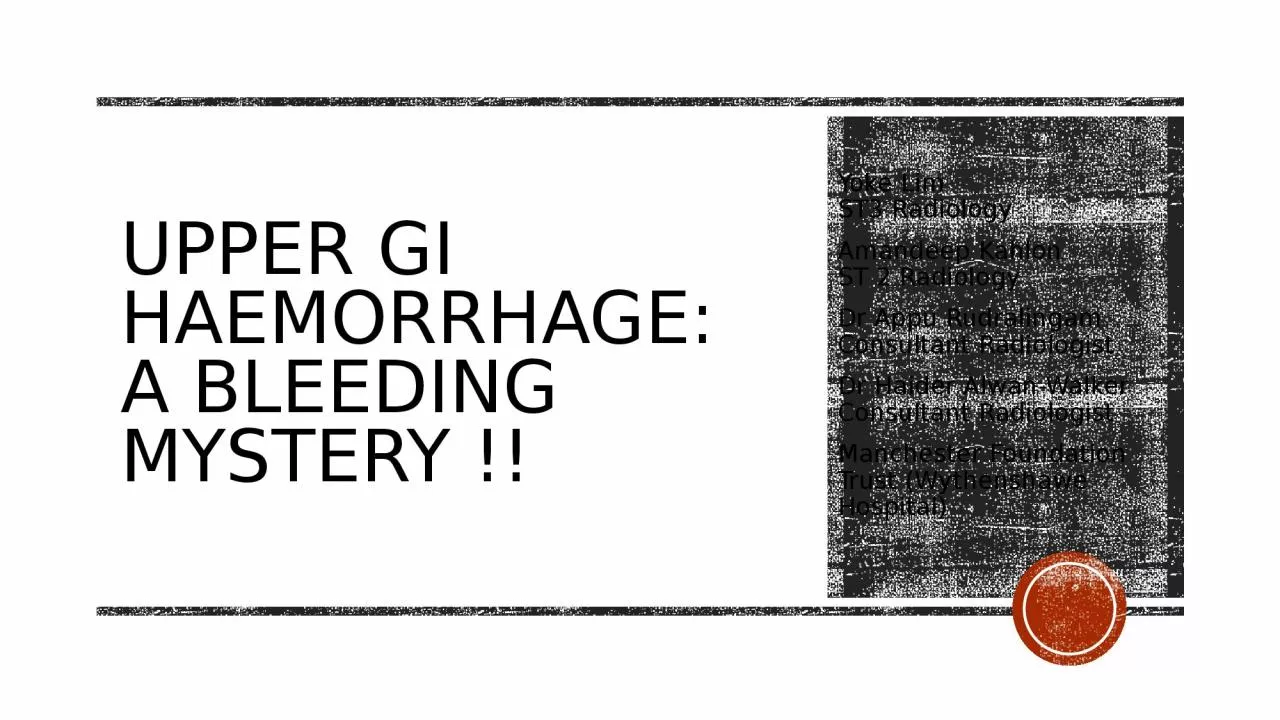

Yoke Lim ST3 Radiology Amandeep Kahlon ST 2 Radiology Dr Appu Rudralingam Consultant Radiologist Dr Haider Alwan Walker Consultant Radiologist Manchester Foundation Trust Wythenshawe Hospital ID: 932378
Download Presentation The PPT/PDF document "Upper GI Haemorrhage: A Bleeding Myster..." is the property of its rightful owner. Permission is granted to download and print the materials on this web site for personal, non-commercial use only, and to display it on your personal computer provided you do not modify the materials and that you retain all copyright notices contained in the materials. By downloading content from our website, you accept the terms of this agreement.
Slide1
Upper GI Haemorrhage:
A Bleeding Mystery !!
Yoke Lim
ST3 Radiology
Amandeep
Kahlon
ST 2 Radiology
Dr
Appu
Rudralingam
Consultant Radiologist
Dr
Haider
Alwan
-Walker
Consultant Radiologist
Manchester Foundation Trust (Wythenshawe Hospital)
Slide2Mr SL44 years, MalePresented with fatigue, long standing epigastric discomfort, haematemesis & melaena.Previous pancreatitis, excessive alcohol intake (32 units/week)Initial bloodsHb 39, MCV 70, WCC 2.6, Plt 187
Slide3Initial ManagementFigure 1A & B: Normal oesophago-gastro-duodenoscopy (OGD) and colonoscopy.
Slide4ct
Figure 2A & B: CT Axial and Coronal demonstrating pseudo-aneurysm (white arrow) in the left gastric artery, directly superior to the pancreas (asterisk).
*
Slide5Angiographic embolisation
Figure 3A & B: Catheter angiogram confirming left gastric pseudo-aneurysm (white arrow), which was successfully coiled (black arrow).
Slide6Readmission…Despite embolization, he represented with a further episode of UGI bleedHb 51Normal OGDRepeat CT angiogram
Slide7ct
Figure 4A & B: CT Axial images demonstrating recurrence of left gastric pseudo-aneurysm (white arrow), despite previous embolization (black arrow).
Slide8Angiographic embolisation
Figure 5A & B: Catheter angiography illustrates recurrence of left gastric pseudo-aneurysm (black arrow) and recanalization of the left gastric artery pass the coil (white arrow). Successful embolization achieved with Onyx
TM
(white arrow head).
Slide9Readmission 2…3 months later, further admission with melaena.Hb 74Normal OGD.Tc RBC scan raises the possibility of small bowel haemorrhage.Normal capsular endoscopy.Decision for single balloon enteroscopyFigure 6A & B. Images of RBC scan showing signal uptake in the left upper abdomen at 1
st hour, migrating to the lower abdomen at 4th hour.
Slide10Single balloon enteroscopy
Figure
7A & B: Selected images from single balloon enteroscopy revealing clot in the 2nd part of the duodenum. Active bleeding from the ampulla of Vater seen once clot is retrieved.
Slide11Haemosuccus pancreaticus
Slide12Haemosuccus pancreaticusBleeding from ampulla of VaterCausesChronic pancreatitis –pseudoaneurysm.Vascular malformationPancreatic tumourIatrogenic
Source of pseudoaneurysmSplenic (40%)Gastroduodenal (30%)Pancreaticoduodenal (20%)
Slide13Haemosuccus pancreaticusSymptomsIntermittent repetitive UGI bleed – difficult diagnosisMelaena – most commonHaematemesisEpigastric painDiagnosisClinicalRadiologyCross sectional imagingAngiographyEndoscopy
Bleeding from ampulla of Vater
Slide14Haemosuccus pancreaticusManagementInterventional radiologyAngiographic embolizationImmediate success rate - > 60%Recurrence rate – 30%SurgeryUnsuccessful embolizationSuccess rate – 70 – 85%Rebleeding rate – < 5%
Slide15Learning pointsHaemosuccus pancreaticus is a rare cause, but an important differential for UGI bleeding. Challenging diagnosis due to its intermittent nature and obscure bleeding into the main pancreatic duct.Endoscopy remains the gold standard, but radiology plays an essential role in diagnosis and management.